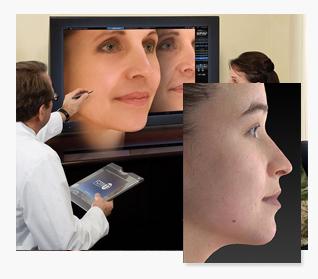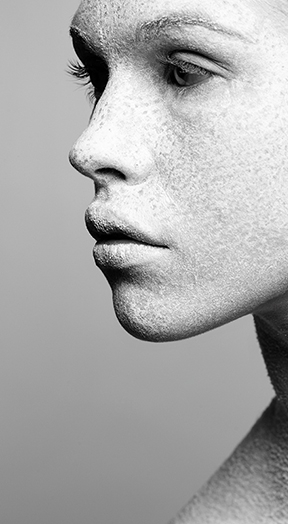Our faces change as we age. There are skin changes, as well as alterations of the deeper tissues. Bay Area Plastic Surgeon John R. Griffin can rejuvenate the appearance of the face and neck by smoothing out the skin and tightening underlying tissues. Learn more about how facelift and necklift techniques can result in a more youthful and freshened appearance.
Vectra 3D Imaging for Facelift and Necklift
|
Vectra 3D imaging technology helps patients visualize their potential individual outcomes. During the facelift and necklift consultation, Dr. Griffin will take a 3D image of the patient. Once the image is displayed on his computer screen, Dr. Griffin will simulate a before and after result by modifying the patients facial contours. The likely outcome can be shown to the patient at any angle. |
Facelift and Necklift Candidates
The best candidates for face and necklift procedures are patients whose facial skin has lost its elasticity, resulting in lines around the mouth and loose skin at the neck and jaw line. Facelift and necklift techniques can treat:
- Jowling
- Nasolabial folds
- Wrinkles or rhytids
- Loose skin
- Loss of muscle tone
A facelift targets the mid face and cheeks, and a necklift improves the appearance of the lower face and neck. Patients that have developed signs of aging around the eyes may be candidates for eyelid surgery alone, while patients who have developed signs of aging along the forehead may be candidates for a browlift.
Most facelift and necklift patients are between the ages of 40 and 70. Patients should be in good physical health.
Facelift and Necklift Techniques
There are various facelift and necklift techniques that can be performed; Dr. Griffin will choose the appropriate technique after examining the patient’s facial anatomy and discussing the patient’s goals.
- Skin technique with SMAS plication: An incision is made in the hairline above the ear, curving around and behind the ear itself, and ending in the hairline below the ear. The skin is lifted up from the underlying muscle and SMAS. The underlying tissues are tightened, and the skin is re-draped without tension.
- Superficial musculo-aponeurotic system (SMAS) technique: The SMAS facelift tightens the skin, as well as the facial muscles underlying the skin, with a different technique than the skin lift. The incision pattern and treatment process is similar to that of the skin technique. The difference is that the underlying muscles are also lifted up as a flap, and repositioned during surgery. The tightening of the muscles and SMAS results in a natural appearance and long lasting results.
- Cervicoplasty: The cervicoplasty technique is used to tighten loose and sagging skin on the neck. In this technique, small incisions may be made behind the ear or under the chin. The neck muscles, platysma, is tightened. The loose skin on the neck is then smoothed out and any excess skin is trimmed away.
- Platysmaplasty: The platysmaplasty technique is designed to tighten the muscle of the neck. As patients age, the platysma may start to protrude from the neck, giving the appearance of two vertical cords or bands down either side of the neck. In the platysmaplasty technique, a small incision is made under the chin; the skin is then lifted away so the muscle can be pulled together and sutured, thus improving the contour of the neckline.
Facelift and Necklift Procedure Steps
When patients undergo facelift or necklift, the following steps will take place:
- A surgical pen will mark the area to be treated
- The patient is put under general anesthesia
- An antibacterial solution will be applied to the face and neck
- The incision will be made behind the ear, along the hairline, and/or under the chin
- The facial and neck skin is elevated
- The underlying muscle is tightened and sutured
- The skin is re-draped across the face and/or neck
- Excess skin is excised and drains are placed
- The incision site is closed with sutures
- The incisions are protected with bandages to prevent infection and accidental re-opening of the incisions
Facelift and Necklift Recovery
Recovery following facelift and necklift takes up to two months. However, most patients feel well enough to return to work and most activities within two to four weeks. However, strenuous exercise should be avoided for at least six weeks after surgery.
Facelift and Necklift Side Effects
The most common side effects of facelift and necklift surgery include swelling, bruising, discomfort, and itching around the incision sites. Patients should keep the head elevated after surgery to encourage healing, and take pain medication as directed.
Facelift and Necklift Risks
There are possible risks and complications that can occur with facelift and necklift surgery. These include:
- Infection at the suture sites; this will be reduced if the incision site is kept clean and dry, and antibiotic medicines are taken as prescribed, both before and after surgery.
- Poor reaction to anesthesia
- Nerve damage
- Seroma
- Hematoma
- Skin discoloration
- Hair loss at the incision site
- Facial asymmetry
- Unfavorable scarring
Facelift and Necklift Results
Facelift and necklift procedures result in smoother skin, a more defined jaw and neck line, and an overall more youthful and fresh-looking appearance. The results of surgery are visible once the swelling goes down and the bruising fades, starting two weeks after surgery. Full facelift results can usually be seen at six to eight weeks after surgery.
Facelift and Necklift Consultations
To schedule a facelift or necklift consultation, contact Dr. John R. Griffin.








